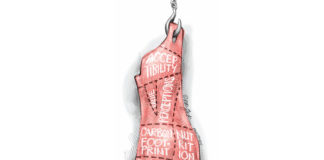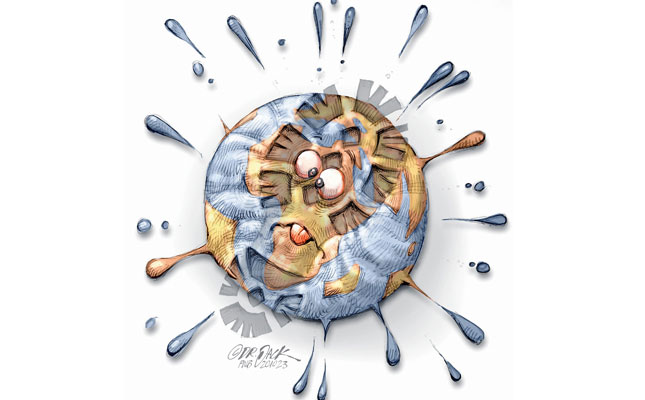The world’s human population has doubled since 1970. There are currently 80 million more human mouths to feed every year, and the population is expected to reach 9,2 billion by 2050.
To adequately meet the nutritional needs of these people, 50% to 70% more farmland at present-day agricultural yields will be needed. If this additional land cannot be found, agricultural production on existing farmland will need to improve dramatically.
The world’s burgeoning middle class, which is set to grow by 3 billion, is also putting enormous pressure on world food resources. Having more disposable income, these middle-class people are improving their diet, and increasingly want more meat in it.
This is especially true in Asia, which is expected to account for 70% of the increase in global demand for meat between 2010 and 2020. All this is good news for livestock farmers, but they will have to improve both productivity and farming processes to take advantage of the situation.
The middle class is not only increasing in size, its members are becoming choosier about what they eat. They are demanding tastier and healthier food, and they want it produced in a humane and environmentally sustainable way. This creates a new set of challenges for farmers.
Another factor that is putting increasing pressure on food stocks and farmers’ ability to feed the world is the growing demand for feedstock crops for biofuels. In 2000, 16 million tons of commercially grown grains were used for bio-ethanol production. By 2010, this figure had grown to 126 million tons, or 25% of the world’s annual grain production.
High prices
Consumer demand pressure on grain stocks, coupled with natural disasters affecting grain production in parts of the world, has seen global grain prices doubling since early 2007. And the fact that farmers are struggling to increase production to meet this demand means that prices are likely to remain high for the foreseeable future.
Although these increases have obviously benefited farmers, consumers have been hard hit – especially in the developing world. And the situation is exacerbated by grain speculators who take high price positions on maize futures.
Another result of high grain prices is that, because grains are widely used as animal feed, the costs of meat production, and thus meat products, have also increased significantly.
The new oil
It is a worry that today, the world has a mere 55 to 65 days of grain reserves. If natural disasters or other factors were to stall global grain production, the world would be in big trouble. Food has become the new oil.
Countries eager to ensure food security for themselves are scrambling to secure their own interests at the expense of the common good. With the United Nations’ Food Price Index at an all-time high and anxious markets sustaining one shock after another, food has rapidly become the hidden driver of world politics. This factor will loom even larger as food crises become increasingly common.
Increasing freshwater scarcity also poses a threat to world food production. Water tables in the world’s most populous countries, India and China, are already dropping. Climate change is making this situation worse by affecting freshwater resources and agricultural production cycles, areas and yields.
Just a 1°C increase in the average world temperature can decrease yields by as much as 10%. What appear to be very small changes in the world’s climate could result in huge differences.
For example, higher temperatures could lead to new dust bowls developing in fertile parts of the world. Rice farmers are already struggling to improve the yields of rice, a staple in heavily populated Asia.
Buying land
As part of their strategies to ensure food security, countries such as China and Korea are buying agricultural land in countries such as Ethiopia and Sudan. China has been trying to buy 5 million hectares in the Philippines, while a South Korean company has bought 6,5 million hectares in Madagascar. Brazil meat companies have acquired producers in the US and the European Union, Ukrainian and South Korean companies are investing in the US, and a Thai company has invested in Russia, the Ukraine and Turkey.
Closer to home, SA farmers, in deals masterminded by Agri SA, have been granted long-term leases on land in African countries such as Mozambique, Zambia and Congo-Brazzaville. Despite all these efforts, a billion people still go to sleep hungry every night. In the developed world, 10% of people’s income is spent on food, while in the developing world 2 billion people spend 50% to 70% of their income on food.
Sustainability
Governments need to address food scarcity by going beyond the symptoms and attacking the underlying causes of the situation. In addition, farmers need to produce more on the same land while using less freshwater and conserving their soils. A failure to manage arable soils for sustainability can lead to these soils becoming permanently unviable.
Finally, two of the greatest challenges bedevilling mankind need to be tackled with vigour: climate change and the growth in human population itself. Governments need to implement and enforce legislation that will lead to climate stability and thus reduce the risk of runaway food prices. And there must be a rapid global shift towards smaller families.
Improvements
On the positive side, there have been remarkable developments in agricultural production in recent years. Genetics improvements, for example, have consistently shaved half a day off broiler target slaughter weights of 2,2kg every year. This is primarily due to birds with better feed conversion ratios.
At the same time, the industry is facing rapidly changing attitudes from consumers, who are increasingly demanding that broilers and other livestock be grown and slaughtered in more humane ways. And there is an ever-geater insistence that food be produced in more sustainable ways and with a lower carbon footprint.
Consumers are also expecting higher food safety standards, a fact that was highlighted after the recent E. coli scare in Europe and North America. Science is making improved food safety possible by developing more accurate testing methods; farmers in turn need to produce food more hygienically.
In addition, today’s consumers are increasingly rejecting food that has been heavily treated with agricultural chemicals and veterinary pharmaceuticals. They are supported by governments in certain countries who are legislating against the overuse of many of these products. Farmers need to adapt to this new demand.
Digital world
One of the greatest features of our modern age is ease of communication and the resultant spread of ideas. Farming too can benefit in this respect. The internet and social media can be used to connect agriculture with consumers, both current and potential. The realities of farming and food production can reach as wide an audience as possible, and the profession of farming itself can be promoted.
Food, like so much else, has become a globalised commodity, and issues involved its production – quantity, quality and sustainability – are more in the public domain than ever. These debates are set to intensify in our increasingly crowded – and connected – world, and farmers need to embrace modern communcation and take part in the discussion.
Aidan Connolly can be contacted at [email protected]. Alternatively, visit www.alltech.com.
Farmer’s Weekly is grateful to the following sponsors for making possible Lloyd Phillips’s visit to the International Federation of Agricultural Journalists’ Congress 2011, held in Canada: The Canadian High Commission in South Africa, Caxton Magazines, Alltech International, Ben and Marielle Ford (Grahamstown, E Cape), James and Glynnis Oberholzer (Rosetta, KZN).













